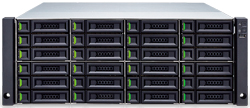RAID LEVELS
RAID LEVEL 6: RAID Level 6 Options | RAID 6 Storage Devices | ACNC
Two independent parity computations must be used in order to provide protection against double disk failure. Two different algorithms are employed to achieve this purpose.
RAID Level 6 requires a minimum of 4 drives to implement

Characteristics & Advantages
- RAID 6 is essentially an extension of RAID level 5 which allows for additional fault tolerance by using a second independent distributed parity scheme (dual parity)
- Data is striped on a block level across a set of drives, just like in RAID 5, and a second set of parity is calculated and written across all the drives; RAID 6 provides for an extremely high data fault tolerance and can sustain multiple simultaneous drive failures
- RAID 6 protects against multiple bad block failures while non-degraded
- RAID 6 protects against a single bad block failure while operating in a degraded mode
- RAID 6 storage is the perfect solution for mission critical applications
Disadvantages
- More complex controller design
- Controller overhead to compute parity addresses is extremely high
- Write performance can be brought on par with RAID Level 5 by using a custom ASIC for computing Reed-Solomon parity
- Requires N+2 drives to implement because of dual parity scheme
Recommended Applications
- File and Application servers
- Database servers
- Web and E-mail servers
- Intranet servers
- Excellent fault-tolerance with the lowest overhead




